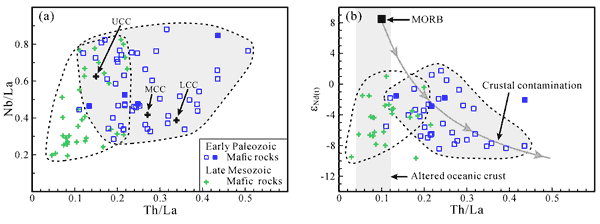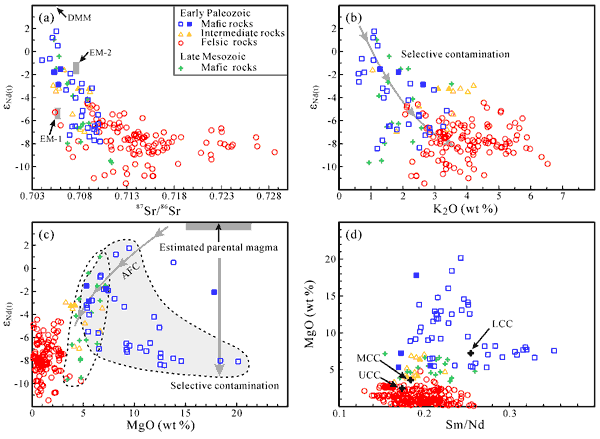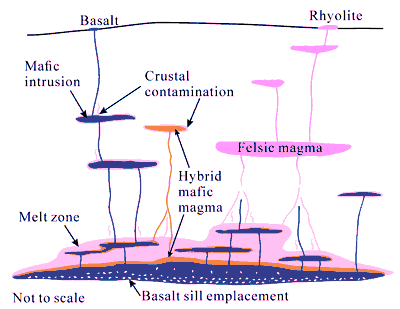 |
Crustal contamination vs. an enriched mantle source for intracontinental mafic rocks:
Insights from early Paleozoic mafic rocks of the South China Block
|
Wenjing Xu, Xisheng Xu & Gang Zeng
State Key Laboratory for Mineral Deposits Research, School of Earth Sciences and Engineering, Nanjing University, Nanjing, 210023, China, wjxu03@gmail.com ; xsxu@nju.edu.cn ; zgang@nju.edu.cn
Compared with typical intraplate magmatic rocks, which are linked to mantle plumes, mantle upwelling, and/or edge-driven convection (Davies & Rawlinson, 2014; Hanson et al., 2006; Pirajno, 2007; Pirajno & Santosh, 2014), silicic magmatic rocks in Silicic Large Igneous Provinces (SLIPs) are believed to be derived from partial melting of the crust triggered by underplating/intraplating of “hidden” large volumes of basaltic magmas (Ernst, 2014). Therefore, mantle-derived mafic magmas are crucial to the formation of SLIPs. Unfortunately, our understanding of the evolution of mantle-derived mafic magmas has been hindered by the paucity of mafic rocks in SLIPs, which is most likely due to the density barrier of low-density felsic magmas encountered by mafic magmas (Ernst, 2014). In our paper we present a detailed study on the early Paleozoic intracontinental magmatic rocks of the South China Block (SCB).
The early Paleozoic intracontinental magmatic rocks in the SCB are dominantly granitoids, which cover a combined area of ~22,000 km2. In contrast, mafic rocks covers only ~45 km2. These mafic rocks have extremely heterogeneous isotopic signatures that range from depleted to enriched (whole rock initial 87Sr/86Sr = 0.7041–0.7102; εNd(t) = –8.4 to +1.8; weighted mean zircon εHf(t) = –7.4 to +5.2). Previous petrogenetic studies indicate they were derived from partial melting of an ancient subduction-modified lithospheric mantle (Wang et al., 2013; Yao et al., 2012; Zhang et al., 2015; Zhong et al., 2013).
Ce/Pb and Nb/U ratios are particularly useful in identifying differences in magma sources because they are sensitive indicators of crustal contamination of mantle-derived mafic magmas. Early Paleozoic mafic rocks from the SCB have low Ce/Pb and Nb/U ratios (0.59–13.1 and 3.5–20.9, respectively), indicating either crustal contamination during stagnation in the crust, or a contribution by the upper oceanic crust and overlying sediments that make up the subducting slab. The Th/La ratio is effective in identifying subduction-related magmas, which have low Th/La ratios (Kessel et al., 2005). The early Paleozoic mafic rocks from the SCB have variable Th/La ratios (0.11–0.51), similar to those of the continental crust, whereas the late Mesozoic mafic rocks from the southeast margin, which are clearly subduction-related, generally have lower Th/La ratios (0.03–0.23; Figure 1a). These early Paleozoic mafic rocks show a negative correlation between εNd(t) values and Th/La ratios (Figure 1b), indicating that the samples with lower εNd(t) values experienced significant contamination by continental crust. In contrast, the late Mesozoic mafic rocks show weak positive correlations between εNd(t) values and Th/La ratios, reflecting a contribution by upper oceanic crust and overlying sediments in the subduction zone.

Figure 1. (a) Nb/La versus Th/La, and (b) εNd(t) versus Th/La diagrams. Click here or on image for enlargement.
Figure 2a shows the extremely heterogeneous Sr–Nd isotopic compositions of the early Paleozoic mafic rocks of the SCB. The variable Sr–Nd isotopic signatures indicate an isotopically heterogeneous mantle source, or assimilation/mixing of magmas from two or more distinct sources. There is a generally good correlation between εNd(t) and K2O (Figure 2b), consistent with selective contamination of these mafic magmas by crust-derived felsic melts during periods of stagnation within the crust (Watson, 1982; Watson & Jurewicz, 1984).

Figure 2. εNd(t) versus initial 87Sr/86Sr (a), K2O (b), and MgO (c) diagrams, and MgO versus Sm/Nd (d) diagram. Trends produced by crustal contamination: (1) assimilation of solid wall-rock during/after fractional crystallization (AFC); and (2) selective contamination by wall-rock-derived melts. Click here or on image for enlargement.
In contrast to the late Mesozoic subduction-related mafic rocks of the SCB, the early Paleozoic mafic rocks show a negative correlation between εNd(t) and MgO (Figure 2c). The high-MgO early Paleozoic mafic rocks (MgO > 10 wt.%) generally have lower Sm/Nd ratios (<0.255) than average lower continental crust (LCC), whereas the majority of the low-MgO mafic rocks (MgO < 10 wt.%) have relatively high Sm/Nd ratios (>0.255) (Figure 2d). The difference in Sm/Nd ratios is consistent with the studies of Huppert et al. (1985) and Reiners et al. (1996), which suggest that primary magmas tend to assimilate a higher proportion of crustal material than do evolved magmas. We propose that the compositions of the high-MgO mafic magmas were more strongly affected by wall-rock-derived felsic melts due to the highly contrasting chemical compositions of the two, as suggested by their trace element and Sr–Nd isotope compositions.
A schematic model (not to scale) of the formation of the early Paleozoic intracontinental magmatic rocks in the SCB is presented in Figure 3. Under- and intra-plated mantle-derived mafic magmas induced melting of the lower to middle crust, and subsequent interaction between the mafic magmas and felsic melts led to the formation of “hybrid mafic magma” (unevolved, high-MgO basaltic magmas with enriched signatures). Periodically, the evolved basaltic magmas, “hybrid mafic magma”, and the felsic melts separated from their sources migrated upwards and were emplaced into the middle to upper crust. The main difference between our model and the MASH model (melting, assimilation, storage, and homogenization) proposed by Hildreth & Moorbath (1988) is that though “hybrid mafic magma” (high-MgO basaltic magmas with fertile signatures, such as noritic magmas) may have been generated by interaction between the mantle-derived basaltic magmas and crust-derived felsic melts, extensive mixture and/or homogenization between the underplated/intraplated mantle-derived mafic magmas and crust-derived felsic melts may not have been achieved.

Figure 3. Schematic model (not to scale) of the formation of the early Paleozoic intracontinental magmatic rocks in the SCB. This figure focuses primarily on the preferential modification of the mafic magma compositions by the felsic melts, though there was generally limited chemical interaction between the mafic magmas and crustal felsic melts (Clemens & Stevens, 2016; Johnston & Wyllie, 1988). The separation of the felsic melts was efficient and they ascended in discrete, narrow dykes (for a detailed discussion, see Clemens & Stevens (2016)).
In summary, our genetic model can explain the varied geochemical and isotopic compositions of the early Paleozoic intracontinental mafic, intermediate, and felsic rocks in the SCB. More generally, our model may also help to explain the varied compositions of magmatic rocks in SLIPs and intracontinental mafic rocks.
References
-
Clemens, J.D., Stevens, G., 2016. Melt segregation and magma interactions during crustal melting: Breaking out of the matrix. Earth-Science Reviews 160, 333-349.
-
Davies, D.R., Rawlinson, N., 2014. On the origin of recent intraplate volcanism in Australia. Geology 42, 1031-1034.
-
Ernst, R.E., 2014. Large igneous provinces. Cambridge University Press, Cambridge, UK.
-
Hanson, R.E., Harmer, R.E., Blenkinsop, T.G., Bullen, D.S., Dalziel, I.W.D., Gose, W.A., Hall, R.P., Kampunzu, A.B., Key, R.M., Mukwakwami, J., Munyanyiwa, H., Pancake, J.A., Seidel, E.K., Ward, S.E., 2006. Mesoproterozoic intraplate magmatism in the Kalahari Craton: A review. Journal of African Earth Sciences 46, 141-167.
-
Hildreth, W., Moorbath, S., 1988. Crustal contributions to arc magmatism in the Andes of central Chile. Contributions to Mineralogy and Petrology 98, 455-489.
-
Huppert, H.E., Stephen, R., Sparks, J., 1985. Cooling and contamination of mafic and ultramafic magmas during ascent through continental crust. Earth and Planetary Science Letters 74, 371-386.
-
Johnston, A.D., Wyllie, P.J., 1988. Interaction of granitic and basic magmas: experimental observations on contamination processes at 10 kbar with H2O. Contributions to Mineralogy and Petrology 98, 352-362.
-
Kessel, R., Schmidt, M.W., Ulmer, P., Pettke, T., 2005. Trace element signature of subduction-zone fluids, melts and supercritical liquids at 120–180 km depth. Nature 437, 724-727.
-
Pirajno, F., 2007. Mantle plumes, associated intraplate tectono-magmatic processes and ore systems. Episodes 30, 6-19.
-
Pirajno, F., Santosh, M., 2014. Rifting, intraplate magmatism, mineral systems and mantle dynamics in central-east Eurasia: An overview. Ore Geology Reviews 63, 265-295.
-
Reiners, P.W., Nelson, B.K., Nelson, S.W., 1996. Evidence for multiple mechanisms of crustal contamination of magma from compositionally zoned plutons and associated ultramafic intrusions of the Alaska Range. Journal of Petrology 37, 261-292.
-
Wang, Y.J., Zhang, A.M., Fan, W.M., Zhang, Y.H., Zhang, Y.Z., 2013. Origin of paleosubduction-modified mantle for Silurian gabbro in the Cathaysia Block: Geochronological and geochemical evidence. Lithos 160, 37-54.
-
Watson, E.B., 1982. Basalt contamination by continental crust: some experiments and models. Contributions to Mineralogy and Petrology 80, 73-87.
-
Watson, E.B., Jurewicz, S.R., 1984. Behavior of alkalies during diffusive interaction of granitic xenoliths with basaltic magma. The Journal of Geology, 92, 121-131.
-
Yao, W.H., Li, Z.X., Li, W.X., Wang, X.C., Li, X.H., Yang, J.H., 2012. Post-kinematic lithospheric delamination of the Wuyi-Yunkai orogen in South China: Evidence from ca. 435 Ma high-Mg basalts. Lithos 154, 115-129.
-
Zhang, Q., Jiang, Y.H., Wang, G.C., Liu, Z., Ni, C.Y., Qing, L., 2015. Origin of Silurian gabbros and I-type granites in central Fujian, SE China: Implications for the evolution of the early Paleozoic orogen of South China. Lithos 216, 285-297.
-
Zhong, Y.F., Ma, C.Q., Zhang, C., Wang, S.M., She, Z.B., Liu, L., Xu, H.J., 2013. Zircon U-Pb age, Hf isotopic compositions and geochemistry of the Silurian Fengdingshan I-type granite Pluton and Taoyuan mafic-felsic Complex at the southeastern margin of the Yangtze Block. Journal of Asian Earth Sciences 74, 11-24.
last updated 3rd January, 2018 |
